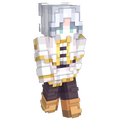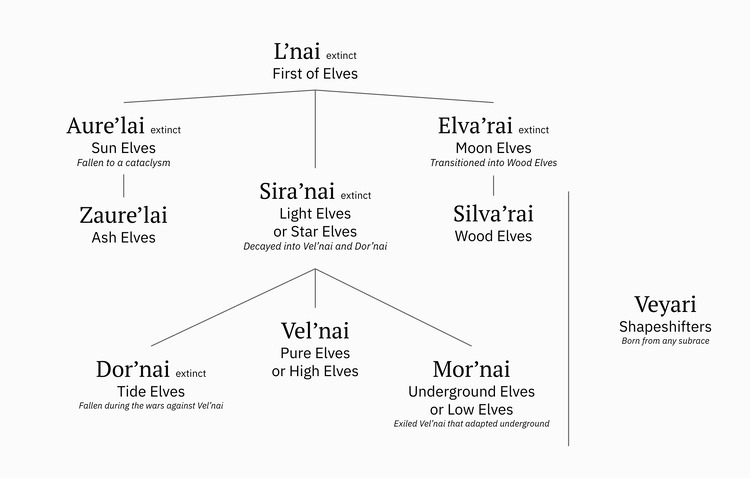High Elves: Difference between revisions
No edit summary |
No edit summary |
||
| Line 25: | Line 25: | ||
* '''Magic Affinity:''' Natural aptitude for arcane arts. | * '''Magic Affinity:''' Natural aptitude for arcane arts. | ||
== Elven Lineage == | == Ancestry == | ||
The Vel’nai originated as a distinct cultural branch of the Sira’nai (Star Elves), who themselves were descended from the primordial L’nai. As the Sira’nai expanded across Alathra, their philosophical interpretations of elven destiny began to diverge. Some chose sea-bound paths (later becoming the Dor’nai), while others, like the Vel’nai, embraced ideological purity and established structured societies grounded in magical order. | |||
This embrace of hierarchy, refinement, and magical scholarship gradually hardened into a doctrine of self-superiority. Over generations, this purist doctrine would be enshrined in both law and bloodline, guiding the Vel’nai into conflict with other elven races. | |||
=== Elven Lineage === | |||
The elves of Alathra trace their origins to the L’nai, the First Elves—primordial beings of long life, arcane potential, and fluid essence. Over the ages, the L’nai gave rise to multiple branches through divergence in philosophy, environment, and magical affinity. | The elves of Alathra trace their origins to the L’nai, the First Elves—primordial beings of long life, arcane potential, and fluid essence. Over the ages, the L’nai gave rise to multiple branches through divergence in philosophy, environment, and magical affinity. | ||
| Line 32: | Line 37: | ||
Scattered among all lineages are the rare Veyari, shapeshifters born with residual echoes of the L’nai essence. Though rare, they are found across all elven communities and maintain no distinct homeland of their own. | Scattered among all lineages are the rare Veyari, shapeshifters born with residual echoes of the L’nai essence. Though rare, they are found across all elven communities and maintain no distinct homeland of their own. | ||
[[File:Elven_Race_Lineage.png|center|frameless|750x750px]] | [[File:Elven_Race_Lineage.png|center|frameless|750x750px]] | ||
== Homeland == | |||
The Vel’nai inhabit the radiant cities of northern and central Alathra, where magic flows freely and light is plentiful. Their cities are built from luminous stone and reinforced with enchantments, featuring spires, great halls, large plazas, markets, etc. | |||
Each Vel’nai domain operates as a semi-autonomous principality ruled by a Magisterium or High Council —an elite council of high mages, seers, and line-bound nobles. These cities are highly stratified, often closed to outsiders without invitation or diplomatic standing. | |||
== Culture == | |||
Vel’nai culture is shaped by hierarchy, discipline, and intellectual ambition. Arcane mastery is both a rite of passage and a social currency, and noble houses vie for prestige through scholarly achievement, magical innovation, and dynastic purity. | |||
'''Core cultural values include:''' | |||
* '''Lineal Perfection:''' Bloodlines are meticulously recorded and selectively continued. | |||
* '''Codified Magic:''' Spells and enchantments are regulated through guilds and archives. | |||
* '''Ceremonial Etiquette:''' Every formal gesture carries symbolic weight. | |||
* '''Knowledge as Dominion:''' Mastery of truth and history is considered a form of rule. | |||
Children are raised within dynastic academies, with education focused on logic, history, magic, and courtly conduct from an early age. Deviance from form or doctrine is frowned upon; excellence and continuity are paramount. | |||
== Language == | |||
The Vel’nai speak ''Nau'Tai'' or ''High Elven'', a tonal, rule-bound language with strict syntactic structure. It is used in both common speech and arcane scripting, often inscribed in concentric glyphs or mirrored scrolls. | |||
Spoken Velenarth is formal and crisp, marked by tonal inflection and rhetorical formality. Written forms include: | |||
* '''Glyphic Cipher:''' Used in spellcraft and magical defense. | |||
* '''Lineal Script:''' Used in genealogy, law, and recordkeeping. | |||
== Abilities & Behaviors == | |||
=== Strengths === | |||
* '''Arcane Mastery:''' Naturally gifted in structured, high-tier magic. | |||
* '''Strategic Governance:''' Skilled in diplomacy, manipulation, and social architecture. | |||
* '''Long-Term Planning:''' Cultural memory and intellectual foresight drive complex initiatives. | |||
* '''Architectural Dominance:''' Their cities are magically fortified and culturally symbolic. | |||
* '''Cultural Influence:''' Through writing, education, and diplomacy, they shape regional ideologies. | |||
=== Weaknesses === | |||
* '''Cultural Arrogance:''' Prone to dismissiveness, which undermines diplomacy. | |||
* '''Overdependence on Hierarchy:''' Systems collapse without leadership. | |||
* '''Magical Rigidity:''' Struggle to adapt to chaotic or unconventional magic. | |||
* '''Isolationist Bias:''' Distrust of outsiders and lesser races hampers alliances. | |||
* '''Disdain for Simplicity:''' May overlook practical or natural solutions in favor of the arcane. | |||
=== Behavioral Patterns === | |||
* '''Social Order:''' Noble-centric with academic meritocracy; elders and mages dominate policy. | |||
* '''Interaction Style:''' Formal, often condescending, but precise. | |||
* '''Conflict Response:''' Prefer subversion, wards, and political undermining before direct warfare. | |||
Latest revision as of 13:52, 20 July 2025
| High Elf | |
|---|---|
| Major race | |
 Example appearance | |
| Attributes | |
| Average lifespan (max) | 800 years (1600) |
| Age of maturity | 150 years |
| Height range | 1.75 - 2.20 m (5′9′′ - 7′30′′) |
Parent Race: Elf
The High Elves, or Vel’nai, are a minor race of elves directly descended from the Star Elves (Sira’nai), a civilization of elves renowned for its celestial study, mathematical systems, and contemplation. Following the migration to Alatrha, the High Elves became one of the most advanced and enduring elven civilizations. They are known for their mastery of arcane magic, structured society, and towering architecture, all built upon a philosophy of ancestral continuity and racial refinement.
Etymology
- Vel’nai: Endonym; from vel (light, pure) + ’nai (essence, bound), meaning “Those of the Pure Line.”
- High Elves: A common name used to distinguish this lineage from other elven branches.
Physical Traits
High Elves are considered physically and aesthetically striking:
- Skin tones: Pale to porcelain, with undertones of silver, gold, or violet.
- Eyes: Bright and often unnaturally reflective—silver, ice blue, amethyst.
- Hair: Ranges from platinum blond to ash-gold, white, or muted silver.
- Posture: Upright and formal; gestures are deliberate, and expressions are restrained.
- Magic Affinity: Natural aptitude for arcane arts.
Ancestry
The Vel’nai originated as a distinct cultural branch of the Sira’nai (Star Elves), who themselves were descended from the primordial L’nai. As the Sira’nai expanded across Alathra, their philosophical interpretations of elven destiny began to diverge. Some chose sea-bound paths (later becoming the Dor’nai), while others, like the Vel’nai, embraced ideological purity and established structured societies grounded in magical order.
This embrace of hierarchy, refinement, and magical scholarship gradually hardened into a doctrine of self-superiority. Over generations, this purist doctrine would be enshrined in both law and bloodline, guiding the Vel’nai into conflict with other elven races.
Elven Lineage
The elves of Alathra trace their origins to the L’nai, the First Elves—primordial beings of long life, arcane potential, and fluid essence. Over the ages, the L’nai gave rise to multiple branches through divergence in philosophy, environment, and magical affinity.
From the L’nai emerged the Aure’lai (Sun Elves), Sira’nai (Star Elves), and Elva’rai (Moon Elves), who formed the three great ancient lineages. Each of these lines would, in time, fragment further into the modern elven subraces of today: the imperial Vel’nai (High Elves), exiled subterranean Mor’nai (Low Elves), extinct seaborne Dor’nai (Tide Elves), forest-bound Silva’rai (Wood Elves), and the remote Zaure’lai (Ash Elves).
Scattered among all lineages are the rare Veyari, shapeshifters born with residual echoes of the L’nai essence. Though rare, they are found across all elven communities and maintain no distinct homeland of their own.

Homeland
The Vel’nai inhabit the radiant cities of northern and central Alathra, where magic flows freely and light is plentiful. Their cities are built from luminous stone and reinforced with enchantments, featuring spires, great halls, large plazas, markets, etc.
Each Vel’nai domain operates as a semi-autonomous principality ruled by a Magisterium or High Council —an elite council of high mages, seers, and line-bound nobles. These cities are highly stratified, often closed to outsiders without invitation or diplomatic standing.
Culture
Vel’nai culture is shaped by hierarchy, discipline, and intellectual ambition. Arcane mastery is both a rite of passage and a social currency, and noble houses vie for prestige through scholarly achievement, magical innovation, and dynastic purity.
Core cultural values include:
- Lineal Perfection: Bloodlines are meticulously recorded and selectively continued.
- Codified Magic: Spells and enchantments are regulated through guilds and archives.
- Ceremonial Etiquette: Every formal gesture carries symbolic weight.
- Knowledge as Dominion: Mastery of truth and history is considered a form of rule.
Children are raised within dynastic academies, with education focused on logic, history, magic, and courtly conduct from an early age. Deviance from form or doctrine is frowned upon; excellence and continuity are paramount.
Language
The Vel’nai speak Nau'Tai or High Elven, a tonal, rule-bound language with strict syntactic structure. It is used in both common speech and arcane scripting, often inscribed in concentric glyphs or mirrored scrolls.
Spoken Velenarth is formal and crisp, marked by tonal inflection and rhetorical formality. Written forms include:
- Glyphic Cipher: Used in spellcraft and magical defense.
- Lineal Script: Used in genealogy, law, and recordkeeping.
Abilities & Behaviors
Strengths
- Arcane Mastery: Naturally gifted in structured, high-tier magic.
- Strategic Governance: Skilled in diplomacy, manipulation, and social architecture.
- Long-Term Planning: Cultural memory and intellectual foresight drive complex initiatives.
- Architectural Dominance: Their cities are magically fortified and culturally symbolic.
- Cultural Influence: Through writing, education, and diplomacy, they shape regional ideologies.
Weaknesses
- Cultural Arrogance: Prone to dismissiveness, which undermines diplomacy.
- Overdependence on Hierarchy: Systems collapse without leadership.
- Magical Rigidity: Struggle to adapt to chaotic or unconventional magic.
- Isolationist Bias: Distrust of outsiders and lesser races hampers alliances.
- Disdain for Simplicity: May overlook practical or natural solutions in favor of the arcane.
Behavioral Patterns
- Social Order: Noble-centric with academic meritocracy; elders and mages dominate policy.
- Interaction Style: Formal, often condescending, but precise.
- Conflict Response: Prefer subversion, wards, and political undermining before direct warfare.